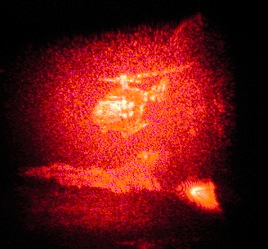OMG! Talk about spinoffs...
As the website said:
Sometimes, we at Medgadget lose our objective, professional detachment and can only say: this would be frickin' awesome.
From
Medgaget:
Holographic Movies for Medical Imaging
You might not expect a professor of biochemistry and internal medicine to develop holographic television. But Dr. Harold Garner is well on his way toward doing just that, and now Popular Science has labelled his early work one of five "great ideas for the future":
The heart of the holographic system is the digital light processing micro-mirror chip, made by Texas Instruments and currently used in television, video and movie projectors. Those devices incorporate a computer that processes an incoming digital signal by rapidly - several thousand times a second - changing the angle of each micro-mirror to reflect light from a regular light bulb. The resulting image is a two-dimensional video projected onto a screen.
...Dr. Garner's system also requires a different kind of digital signal than those feeding into today's projection TV sets. His signal is a sequence of two-dimensional interference patterns, called interferograms, which can be generated either from scratch or from data gathered from 3-D imaging applications, such as sonograms, CAT scans, magnetic resonance imaging, radar, sonar or computer-aided drafting.
"This technology is potentially powerful for medical applications," Dr. Garner said. "We could easily take data from existing 3-D imaging technologies and feed that into our computer algorithms to generate two-dimensional interferograms."
On a computer screen, interferograms look like tiny random black dots similar to an off-the-air TV channel's "snow." But the patterns, when fed into the digital light processing micro-mirror chip, cause the tiny mirrors to change in a way that, when laser light is reflected off them, projects a 3-D moving image that appears suspended in air, in a special material called agarose gel, or on a stack of liquid crystal plates similar to computer screens.
"Holographic visualization of organs, for example, would improve diagnosis of ailments such as a swollen, damaged or malformed heart," Dr. Garner said. Other possible medical applications include visualization aids for training surgeons, measuring teeth and bone development, and viewing the possible results of plastic surgery before it's actually done.
Sometimes, we at Medgadget lose our objective, professional detachment and can only say: this would be frickin' awesome. One of us is particularly tickled by the fact that the 3D images are reconstructed in a tank filled with agarose gel, which was a prominent player from our laboratory days.
There's more at Dr. 'Skip' Garner's website, 'Garnering Information'. There's no movies of beating human hearts yet, just some helicopters and fighter jets - because those are cool too.
Ring Ring Ring... Dr. Gardner, this is Dr. Lindstrom from the Nobel Prize Committee. Are you available to come to Stockholm this Fall.
Wanting to decrypt holographic data and seeing that an off-the-shelf Texas Instruments DLP MEMS chip would do the job well is pure Genius in my book...
It is easy to have an idea.
It is less easy to bring the idea to a successful fruition.
It is downright hard to bring the idea to a successful fruition with C.O.T.S. technology.
(Commercial Off The Shelf)
Here is a frame from a
video available here

and sure, the image is grainy and monochrome but so were the first Holograms. This video made me think of Doug Trumbull's 1983 film
Brainstorm. I can't find any images online but the main plot device was a helmet that could record and play back thoughts and experiences. When first revealed in the film, it was a huge device with fumes from liquid gasses swirling about. At the end of the film, it was a stylish coronet about the size of a pair of sunglasses...
Technology moves on and this is one to follow -- I will be there with some $$$ should Dr. Garner's company ever go public...
Posted by DaveH at June 17, 2005 9:35 PM
